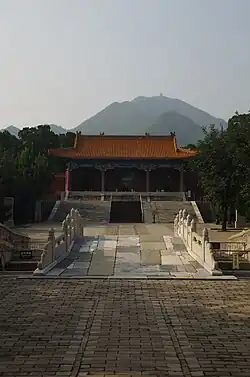| Ming Zhaoling | |
|---|---|
明昭陵 | |
 Ling'en Gate of Zhaoling Mausoleum | |
| General information | |
| Location | Changping District, Beijing |
| Country | China |
| Coordinates | 40°17′26″N 116°12′40″E / 40.29056°N 116.21111°E |
The Ming Zhaoling (Chinese: 明昭陵; pinyin: Míng Zhāolíng) is a mausoleum in China where the Longqing Emperor was buried. Zhaoling is one of the thirteen imperial tombs at Ming tombs in Changping district 45 km north of central Beijing.[1]
The Longqing Emperor was the 13th emperor of the Chinese Ming dynasty (1368–1644), reigning from 1566 until his death in 1572. He was buried in Zhaoling, one of the thirteen imperial tombs in the Ming tombs complex. His first wife, Empress Li, who died in 1558, was also interred at Zhaoling. Later, the emperor's two other wives, Empress Xiao'an and Empress Xiaoding, were also laid to rest there.[2]
Zhaoling is the only tomb in the Ming tombs complex that has undergone a significant renovation, which took place in 1980. It was opened to the public in 1990 and is one of the three tombs in the complex that are accessible to tourists, along with Changling and Dingling.[2][1]
Zhaoling was originally built as a tomb for the Jiajing Emperor's parents, but for various reasons, the Wanli Emperor chose to bury his father, the Longqing Emperor, there instead. The construction of Zhaoling was completed in 1573, and it follows a similar architectural style to other Ming tombs. The complex is centered around a continuous geometric axis, beginning with a stele in a pavilion. This is followed by the Ling'en Gate and the Ling'en Hall (隆恩殿), which was used for paying respects to the Longqing Emperor by successive emperors. The Minglou Tower is the next building, enclosed by a square castle. This castle then connects to Bao Cheng (宝城), a circular wall that encloses the burial mound. The mound itself is an artificial circular structure made of packed earth, beneath which lies the underground palace where the deceased are laid to rest. Similar to the Eastern Qing tombs and Western Qing tombs, the Ming tombs also feature a courtyard with a sacred kitchen and storeroom located near the entrance to the tomb. However, Zhaoling is the only Ming tomb where these buildings have been preserved. The entire complex covers an area of 34,000 square meters.[2]
The name Zhaoling has been used for other Chinese imperial tombs as well. The Tang dynasty Emperor Taizong (died 649) is buried in Zhaoling, located northwest of Xi'an, while the Qing dynasty emperor Hong Taiji (died 1643) is buried in Zhaoling in Shenyang, Liaoning province.
Gallery
 Side-view of Zhaoling Mausoleum (Bird's-eye view from Zhaoling Village)
Side-view of Zhaoling Mausoleum (Bird's-eye view from Zhaoling Village).jpg.webp) Shengong Shengde Stele Pavilion
Shengong Shengde Stele Pavilion.jpg.webp) Ling'en Gate of Zhaoling Mausoleum
Ling'en Gate of Zhaoling Mausoleum.jpg.webp) Ling'en Hall of Zhaoling Mausoleum
Ling'en Hall of Zhaoling Mausoleum Lingxing Gate of Zhaoling Mausoleum
Lingxing Gate of Zhaoling Mausoleum Minglou Tower of Zhaoling Mausoleum
Minglou Tower of Zhaoling Mausoleum
References
- 1 2 Lu, Baouchun (2006). "Zhaoling". Imperial mausoleums of China 中国皇帝陵. China national art photograpg publishing house. p. 120–121. ISBN 7-80069-732-0.
- 1 2 3 Wang, Yonglin (2011). "Zhao Tomb of Emperor Longqing". Thirteen Imperial Tombs of the Ming Dynasty. Peking: Foreign Languages Press. p. 117–118. ISBN 978-7-119-06755-1.